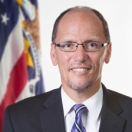
Ed. note: This is cross-posted from Work in Progress, the official blog of the U.S. Department of Labor. See the original post here.
For most of us − myself included − this is the time of year for an honest self-evaluation. Maybe your New Year’s resolutions are the same as mine: spend time with family, exercise more, eat healthy.
Similarly, it’s the time that businesses and government agencies review accomplishments and decide what areas need improvement. Among the many year-end reports that have been released, there is one in particular that shouldn’t be overlooked: the “2012 Employment of People with Disabilities in the Federal Executive Branch Report,” issued recently by the Office of Personnel Management.
It revealed a tremendous accomplishment: more people with disabilities are in federal service, both in real terms and by percentage, than at any time in the past 32 years. This includes more people in high-level positions, and a significant number of disabled veterans. And as OPM Director Katherine Archuleta noted, we’re well on our way to meeting the president’s goal of hiring 100,000 people with disabilities in five years.
While it’s good and important to set goals − both to improve ourselves and to make important changes in the federal workforce, such as hiring more people with disabilities − it’s not about reaching a magic number. It’s about changing attitudes and lives. It’s a moral and economic imperative. And for our country to remain competitive in the 21st-century global economy, we simply can’t afford to have so many people out of the workforce who can and want to work, pay taxes and contribute to our economy.
That’s why we can’t rest on our laurels. In fact, the good news in this report should only encourage us to do more this year and in the years to come.
Currently, only one in five people with disabilities are participating in the U.S. labor force at all. That’s not acceptable. What I hear from people with disabilities is that they want the feeling of pride and purpose that comes performing a job and earning a paycheck at the end of the week.
As the nation’s largest employer, the federal government has a responsibility to be a model in this area. Employers have recognized for some time that it’s smart business to have a diverse workforce − one in which many views are represented and everyone’s talents are valued. Well, disability is part of diversity. I agree wholeheartedly with Director Archuleta: “By including more people with disabilities in the federal workforce, we are stronger and better able to serve America.”
I’m aware of the challenges. But there are a lot of myths − and excuses − out there.
Take workplace accommodations. If you think about it, all workers require some kind of accommodation. Need lights to see in order to do your job? My colleague, Assistant Secretary of Labor for Disability Employment Policy Kathy Martinez, is blind − she doesn’t. Same goes for that office chair: a former colleague, Justice Department trial attorney Joy Welan, doesn’t need one because she uses a wheelchair. Accommodating workers with disabilities is generally easy and affordable. In fact, more than half of job accommodations for employees with disabilities cost nothing.
In 2014, we’ll continue to build on our efforts with state and local governments, business leaders, workforce professionals and others to tap the pool of talent represented by people with disabilities − because the progress we need will only happen when everyone is on board.
I hope that you will join me in my Near Year’s resolution as the secretary of labor − it’s a resolution I make every day: to protect, promote and expand opportunity for everyone willing to work hard, and that includes people with disabilities.
Follow Secretary Perez on Twitter as @LaborSec.


